Tour de France in Wines: A Selection of 8 Three-Bottle Gift Sets + A Gift That Keeps on Giving: ‘The Champagne Society’ Membership 6-Month ($279) or 12-Month ($499) Subscription
This holiday season, Elie’s proud to offer several gift packages intended to showcase the marvelous styles and innovations that are occurring throughout the major growing areas of France. These packages have been curated with a nod toward typicity and quality, and each one will include a printed information sheet describing the domains, the winemakers and the grape varieties that make up the wines. These represent selections from some of our favorite winemakers and will take your gifting prowess to a new level! All bottles are, of course, available individually as well.
In addition, we are offering an opportunity to gift a Membership to ‘The Champagne Society’ to your effervescent friends: 6 Months ($279) or 12 Months ($499) + Pick 3 Bottles from (Standout Dozen of the Year) List for Pre- Packaged Box.
Gift a Membership Subscription to
‘THE CHAMPAGNE SOCIETY’
(A Bimonthly Club)
Lily Bollinger once said, “I only drink champagne when I’m happy and when I’m sad. Sometimes I drink it when I’m alone. When I have company, I consider it obligatory; I trifle with it if I’m not in a hurry and drink it when I am, otherwise I never touch the stuff unless I am thirsty.”
Not only is Champagne the quintessential drink of celebration, it has traditionally been a gift given with ramped-up sentiments. This year we are offering a couple of variations on this theme, beginning with an opportunity to gift a special someone a six-month or twelve-month membership to The Champagne Society . Our pick for December, Champagne Fleury , will be packaged in a wrap-ready gift box along with a congratulatory certificate explaining what lies ahead in bi-monthly installments:
Six-Month Membership Gift ($279) – Bimonthly
You will take home a pre-packaged, ready-for-gift-wrapping box containing The Champagne Society December Selection bottle, Champagne Fleury, with a certificate congratulating the recipient on their new membership to the Champagne Society, a select community of like-minded folks who appreciate the exceptional in life and recognize that wine is a superlative among man’s culinary creations. Then, in February and April, they are eligible to receive two more installments, one Champagne bottle each month (described in detail, in advance, by email), which they can stop by the store to pick up in person or have shipped directly to their home at no additional cost.
Twelve-Month Membership Gift ($499) – Bimonthly
A full year’s membership in the Champagne Society includes a pre-packaged, ready-for-wrapping gift box containing The Champagne Society December Selection bottle, Champagne Fleury, along with a congratulatory certificate informing the recipient that they are now part of the Champagne Society, whose members are eligible for discounted prices on highly allocated Champagne, many bought directly, and many available only through Elie Wine Company. Then, in February and April, June, August and October, they are eligible to receive five more installments, one bottle of Champagne each month (described in detail, in advance, by email), which they can stop by the store to pick up in person or have shipped directly to their home at no additional cost.
Provence: Captured Sunshine
The phrase ‘Mediterranean climate’ applies to no region more succinctly than to Provence, where the furthest vineyard from the Mediterranean is a mere 25 miles away and the vines enjoy 3000 sunshine hours per year along with an annual average temperature of 58°F. These long, dry summers provide ideal harvest conditions in most years, leaving the majority of the grape-growers free from worry about unwanted rot and vine disease. As a result, the use of pesticides and herbicides can be kept to a minimum and the wines are, without fanfare, organic.
Stretching 125 along the European coast and featuring a multitude of terroirs, Provence has surprisingly few sub-appellations. The largest is in the east, Côtes de Provence, which accounts for around 50,000 acres of vineyards. The west of Provence contains the region’s second-largest appellation, Côteaux d’Aix-en-Provence, which draws from about 10,000 acres.
While the popular stereotype of Provence wine is a Côtes de Provence rosé, it is the smaller, more peripheral appellations that make the region interesting to wine enthusiasts, where grape varieties are found that grow nowhere else. Besides the familiar trio made famous by nearby Rhône (Grenache, Syrah and Mourvèdre) and commercial powerhouses like Cabernet Sauvignon, pockets of indigenous and fascinating grapes remain, including Barbaroux, Calitor, Tibouren and Vermentino, each making distinct—and distinctively Provençal wines.
[$145] Provence Set
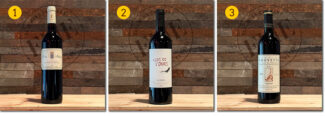
Domaine Roche Redonne (AOP Bandol)
Made up of eight wine-loving communes surrounding a cozy fishing village, Bandol breaks the Provençal mold by producing red wines that not only outstrip the region’s legendary rosé, but make up the majority of the appellation’s output. In part that’s due to the ability of Bandol vignerons to push Mourvèdre—generally treated as a blending grape in the Côtes du Rhône and Châteauneuf-du-Pape—to superlative new heights.
About an hour’s drive east from Marseille, the microclimate that sets Bandol apart from the rest of Provence is the result of altitude and a natural amphitheater; the vines are planted on steep hills where the soils are composed of limestone, red clay and silica sand and the vines are protected from the harshest winds by a geographic bowl formed in the low coastal mountain ranges between La Ciotat and Toulon. This combination of features make it ideal for ripening finicky, late-budding Mourvèdre, which might otherwise be challenged by the proximity of the Mediterranean.
Founded in 1979 by Henri and Geneviève Tournier, Roche Redonne is situated among the Bandol foothills surrounded by olive groves and garrigue scrub just outside the pretty village of La Cadière d’Azu. The 30-acre vineyard is farmed using organic methods and the vines (Mourvèdre, Cinsault and Grenache) now average more than 40 years old, with the youngest vines at 20 years and the oldest at 60. The yields are kept low, and in fitting with the appellation laws, the steeply hilly vineyards are harvested by hand.
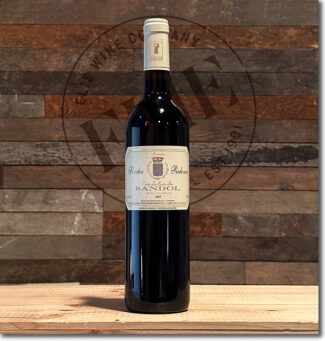 1. Domaine Roche Redonne ‘Cuvée Les Bartavelles’, 2019 Bandol ($69)
1. Domaine Roche Redonne ‘Cuvée Les Bartavelles’, 2019 Bandol ($69)
Made from 95% Mourvèdre and 5% Grenache, ‘Bartavelles’ means ‘Royal Partridges’, and there is certainly a noble delivery here: On the nose, lovely scents of ripe black fruit, licorice and sweet spice waft above a powerful, full-bodied palate with notes of blueberry, wild herbs and peppery spice.
Clos de l’Ours (AOP Côtes de Provence)
Côtes de Provence is the largest appellation in Provence, and although it is allowed to produce both red and white wines, it is the source for more than 80% of Provence’s rosé, made predominantly from Grenache, Syrah, Mourvèdre and Cinsault along with the quintessentially Provençal red grape Tibouren. The terroir is varied, ranging from the slightly cooler sub-alpine hills around Seillans in the north, to the coastal vines around the Golfe de Saint-Tropez in the east and the Baie de la Ciotat, between Bandol and Cassis in the west.
L’Ours translates to ‘bear’—the Brotons family identity and an affectionate nickname for their patriarch, Michel. In 2008, Michel and his wife Fabienne sold the family jewelry business in Marseille to pursue a winemaking dream in Provence, finding a 32-acre estate in a northern corner of Côtes de Provence planted to old vine Rolle, Clairette and Ugni Blanc, used for their white wine portfolio and Syrah, Grenache, Mourvèdre, Cinsault and Carignan for their red and rosés.
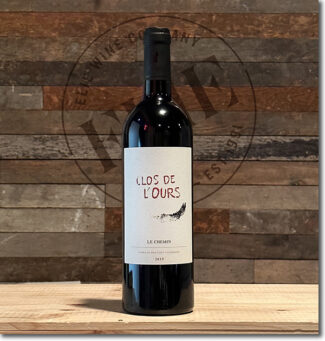 2. Clos de l’Ours ‘Le Chemin’, 2019 Côtes de Provence ($36)
2. Clos de l’Ours ‘Le Chemin’, 2019 Côtes de Provence ($36)
A blend of 37% Grenache, 34% Mourvèdre and 29% Syrah made with a minimum of intervention, wild yeast and no filtration. The wine shows dried raspberry and cassis behind firm acidity and integrated tannins.
Domaine Hauvette (AOP Les Baux de Provence)
Commonly known simply as ‘Baux’, this small appellation is located in the Alpilles Mountains atop a rocky outcrop overlooking the broad plains to the south. Its name refers to the site: In the Provençal language, ‘bauç’ is a rocky spur, and from the commune’s name, the word ‘bauxite’ was coined for aluminum ore discovered there. Wedge between the Rhône delta to the south and Avignon to the north, the wines of Les Baux de Provence are as much Rhône Valley in style as Provence. By law, two of three primary Rhône varieties (Grenache, Syrah and Mourvèdre) must be included and make up at least 60% of the final blend, with Cinsault replacing Mourvèdre in the rosé wines. But traditional Provençal varieties Carignan and Counoise may constitute up to 30% of the wines and Cabernet Sauvignon, brought to Provence from Bordeaux in the 1960s, is also allowed in small quantities.
Domaine Hauvette is very much a part of the picturesque Provençal landscape that inspired Van Gogh’s ‘Starry Nights’, where the Mistral blows for half the year and garrigue is omnipresent. In 1980s Dominique Hauvette left her job as a lawyer in the Savoie and re-discovered her passion for raising horses amid a sunnier climate. She began studying oenology, with an emphasis on making natural wine, and today oversees 42 acres of clay limestone terroir.
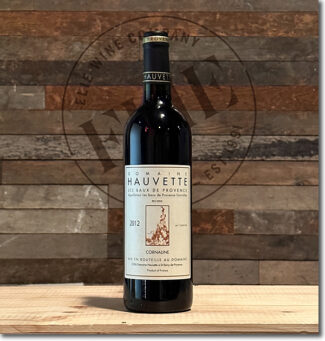 3. Domaine Hauvette ‘Cornaline’, 2012 Les Baux de Provence ($40)
3. Domaine Hauvette ‘Cornaline’, 2012 Les Baux de Provence ($40)
50% Grenache, 30% Syrah and 20% Cabernet Sauvignon farmed biodynamically in cretaceous limestone from the favored lieu-dit ‘Béton.’ The Grenache spearheads the fruit and texture while the Cabernet brings herbal notes and completes the spicy tannic structure of the Syrah.
Southern Rhône: Grenache Takes Center Stage
Although Châteauneuf-du-Pape remains her heart and soul, Southern Rhône slithers across a vast, fertile territory, producing 95% of Rhône Valley’s total wine output. It follows a vinous path beginning in the commune of Montélimar, about 30 miles south of Valence, and extends to the medieval city of Avignon, once the seat of the Catholic popes.
The climate here is considerably warmer than it is along the Rhone’s northern banks, and the favored grape varieties are those that thrive best through hot and humid summers. Unlike its northerly neighbor, which relies heavily (and at times entirely) on Syrah, wines from the south are generally blends based on a balance of viniculture’s Holy Trinity—Grenache, Syrah and Mourvèdre—along with a legion of other grapes. These wines often represent tremendous value as well as a diverse tasting experience comfortably described as ‘sunny’ because of the bright fruit and warm herb notes expressed.
[$104] Southern Rhone Crus Set
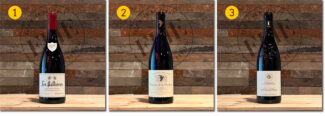
Domaine Les Pallières (AOP Gigondas)
Thanks in the main to the region’s Mediterranean climate and red clay-alluvial soils, the wines of Gigondas are Grenache-based; 50% Grenache is required by law, with Mourvèdre and/or Syrah accounting for the remaining blend, adding structure and savoriness to the richness of Grenache. Under the AOP regulations, only red and rosé wines may be produced in Gigondas; white wines are simply declassified as Côtes-du-Rhône. Once considered of a diminutive version of the majestic Châteauneuf-du-Pape, Gigondas’ Grenache is often grown at higher elevations in terraced vineyards and, in recent years especially, offers an amazing value.
Found just outside the village of Gigondas, within the foothills of the beautiful and brooding Dentelles de Montmirail, the estate had been a continuously running farm within the same family since the fifteenth century until 1998, when it was sold to Daniel and Frédéric Brunier of famed Old Telegraph.
As in CdP, the Brunier brothers focus on the terroir of the vineyards, which lie at altitudes between 800 and 1300 feet with varying proportions of sand and clay woven through the limestone scree. Terraces were built and reinforced to allow better water retention and the many lieu-dits, once blended into one cuvée of Gigondas, have been separated into two in an effort to best express two remarkable personalities. Cuvée ‘Terrasse du Diable’ encompasses the low-yielding vines from the higher altitudes while Cuvée “Les Racines” showcases the vineyard parcels surrounding the winery—the origin of the estate with the oldest vines—with the emphasis on freshness and extravagant fruit.
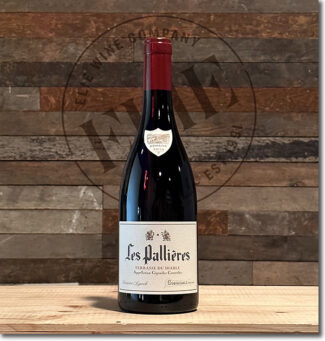 1. Domaine Les Pallières ‘Terrasse du Diable’, 2018 Gigondas ($42)
1. Domaine Les Pallières ‘Terrasse du Diable’, 2018 Gigondas ($42)
A high-altitude cuvée where Grenache makes up 85% with Mourvèdre taking care of the remainder. Yields are about half what the estate generally permits and the vines, over fifty years old, are terraced against the imposing limestone cliffs of Les Dentelles de Montmirail. The wine is garrigue-focused, showing black olive. licorice, mint, eucalyptus and rosemary.
Domaine de la Mordorée (AOP Lirac)
To say that the wines of Lirac are lyrical is not just a pun; the noted combination of elegant perfume and savory grace softens the might. Lirac’s reds are similar in style to the softest of the Côtes du Rhône Villages but miles ahead in complexity: 85% of Lirac production is red, with rosés accounting for 5% and whites the remaining 10%.
Lirac’s two thousand acres are directly across the Rhône from Châteauneuf-du-Pape, and the appellation shares the same iconic rolled pebbles scattered throughout the sandy limestone soils. Vineyards on Lirac’s upper terraces are generally made up of red clay and the large pebbles are here known as ‘terrasses villafranchiennes’; the soil of the lower vineyards shows more loess and clay-limestone. All elevations are prone to summer drought and, under certain strictures, irrigation is allowed.
“The terroir of Lirac is often hidden in the shadows of Châteauneuf-du-Pape,” says Laure Poisson of Les Vignerons de Tavel & Lirac. “But in recent years, Lirac has emerged from the shadows to become something different, something unique.”
GSM represents the Big Three in Southern Rhône, but at Domaine de la Mordorée, the most significant trio is Christophe and Fabrice Delorme along with their father Francis. In 1986, they purchased an estate in Tavel with the intention of producing world-class wine while remaining true to an ecologically-sound stewardship of their land. The success of the venture may be measured by the glowing praise heaped upon them by Robert Parker Jr. in 2007: “With 135 acres spread throughout some of the most impressive appellations of the southern Rhône, Christophe Delorme and his brother have produced one exquisite wine after another. Of course, the top cuvées of Châteauneuf-du-Pape are rare and expensive, but this is a place to find terrific Côtes du Rhônes and Liracs as well. Delorme is equally adept at dry whites as well as reds, and turns out some stunning rosés both under the Côtes du Rhône and Tavel appellations.”
With the untimely passing of Christophe in 2015, his daughter Ambre has stepped in; also invaluable to the current team is winemaker Rémy Chauvet, who worked as Christophe’s cellar manager. The 135 acres mentioned by Parker Jr. cover 38 parcels in Tavel, Châteauneuf-du-Pape, Lirac, Côtes-du-Rhône and Condrieu; the variety of terroirs thus explored make trellising a vital consideration. Says Fabrice, “Goblet training is used for older, un-trellised vineyards, with the canopy remaining free, a traditional pruning method provides better resistance to wind and drought and lesser sensitivity to trunk diseases. Cordon de Royat training is used for newer, trellised vineyards. The newer method allows for higher vines, leaving a larger leaf surface exposed to the sun, which yield colorful grapes that are richer in tannins and in sugar.
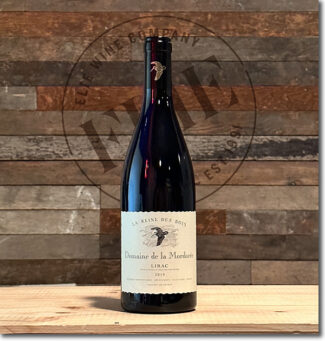 2. Domaine de la Mordorée, 2019 Lirac ($34)
2. Domaine de la Mordorée, 2019 Lirac ($34)
Half Grenache and half Syrah from a fifty-acre plot of forty-year-old vines grown in pebbles rolled over red clay. Fittingly, the wine shows aromas of red fruits and flowers; the palate is full, rich, ample and nicely concentrated.
Domaine La Garrigue (AOP Vacqueyras)
Adjacent to Gigondas, nestling at the foot of the Dentelles de Montmirail and extending beyond the commune of Vacqueyras to Sarrians, Cru Vacqueyras was once known for the rustic quality of its wine. In recent years, however, producers have sought—and obtained—elegance to offset the brambles. The vineyards of Vacqueyras are generally found at lower elevations where it is warmer than their neighbors’ hillside sites. Many of the vines are planted in the Garrigues, or flatlands, which are covered with pebbles, although there are a few higher-elevation vines found on the region’s sandy slopes and stony terraces. Compared to Gigondas, Vacqueyras has always been a more user-friendly wine, offering more fruit, warmth and spice.
In the world of wine, longevity is the consumption devoutly to be desired; it means staying power, both on the palate and in the field. Domaine La Garrigue was founded in 1850 by the same family that runs the property today. Brothers Maxime and Pierre Bernard are at the helm, with wives, children, nieces and nephews all at work, and there is plenty to be done: At over two hundred acres, it is the largest domain in Vacqueyras. There are three terroirs in Vacqueyras, and La Garrigue has plots in each of them, aware of what each brings to the party. Red-clay-under-galets plateau of La Garrigue (not coincidentally, where Domaine la Garrigue is located) offers power and depth, the sandy soils around the village of Vacqueyras bring finesse and the rocky limestone slopes at the foot of the Dentelles de Montmirail mean structure.
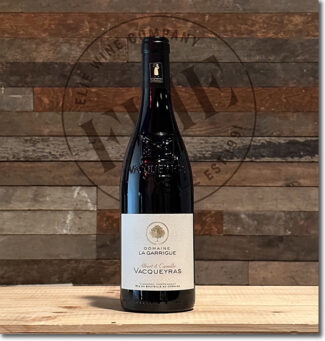 3. Domaine La Garrigue ‘Albert & Camille’, 2019 Vacqueyras ($28)
3. Domaine La Garrigue ‘Albert & Camille’, 2019 Vacqueyras ($28)
75% Grenache, 10% Syrah, 10% Mourvèdre and 5% Cinsault grown on clay-limestone and sand on an ancient river terrace. La Garrigue’s flagship wine is a quintessential and charming Vacqueyras loaded with brandied cherry, Damson plum and mulberry above complex undertones of leather, pepper and spice.
[$180] Chateauneuf-du-Pape Set
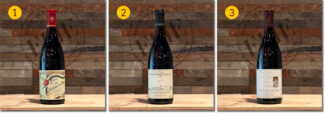
The best—and by most accounts, the most reliable—of the many Côtes du Rhône labels is the insignia-embossed Châteauneuf-du-Pape, which hails from a remarkable region between the towns of Orange and Avignon. Named for the castle built by the 14th Century Pope John XXII, this heavily-extracted wine is the template after which most Côtes du Rhône reds model themselves, and in fact, it’s the copycats that persuaded the producers of genuine Châteauneuf-du-Pape producers to apply to the French government to protect their name, making it the first AOC in France. The unique combination of precipitation (Châteauneuf-du-Pape is very dry) and wind (the powerful Mistral blows in from the Gulf of Lion in the northern Mediterranean) and especially, the large,
As a result, Châteauneuf-du-Pape is largely built around this grape, typically grown on low bush vines. Syrah adds black-fruit spice, and is grown on cooler higher ground; Mourvèdre brings flesh and acidity, and makes up about 10% of a typical blend. To a decreasing extent, Cinsault is used for aromatics; a total of 13 varietals are permitted, giving the wine a legendary and almost unrivaled complexity. Big-shouldered, occasionally blustery, Châteauneuf-du-Pape wine may, in ideal vintages, be as enjoyable to drink in its youth as it is with age. When young, a core of perfumed fruit tames the tannins and acidity, and tempers into rich leather and smoky, earth-tones as it grows older.
Limited to five communes, Châteauneuf-du-Pape commands prices worthy of its reputation, but many of the estate’s own vines just outside the tight borders and there are some plots on which some vineyard rows may be labeled Châteauneuf-du-Pape and adjacent rows , Cotes du Rhone. The finest of these facing the challenge of bureaucracy rather than terroir.
Domain of Ferrand (AOP Châteauneuf-du-Pape)
Domaine de Ferrand is a 13-acre estate under the winemaking chops of Philippe Bravay, who took over his family’s domain some years ago and was the first in the group to bottle his own wine. With organic farming underpinning his operation, Bravay has amassed a cult following for his pure, unadulterated expressions; Robert Parker Jr. refers to him as ‘brilliant’.
More than half of the vines on the estate are more than 100 years old and Bravay insists on organic viticultural methods. Domaine de Ferrand’s signature Châteauneuf-du-Pape is typically 80% Grenache, 15% Syrah and 5% Cinsault.
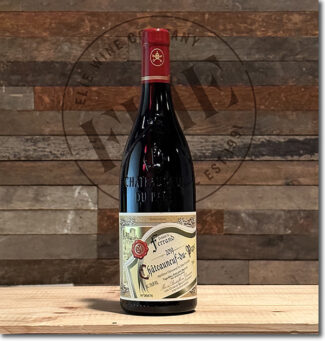 1. Domaine de Ferrand, 2019 Châteauneuf-du-Pape ($64)
1. Domaine de Ferrand, 2019 Châteauneuf-du-Pape ($64)
85% Grenache with the rest a field blend of allowable varieties, including Bourboulenc, Cinsault, Mourvèdre and Syrah, from a prized neighborhood near Orange; the wine displays wildflower, Asian spices, lavender and Bing cherry.
Domain Giraud (AOP Châteauneuf-du-Pape)
The estate may be considered the love-child of Pierre and Mireille Giraud, the union of two venerable wine families. Pierre Giraud can trace his winemaking roots back six centuries while Mireille Buou’s family owned a village distillery for several generations. In 1974, the couple began to cultivate ten acres as sharecroppers, and over the course of a dozen years, acquired local land. In 1981, they transformed the Buou distillery into a winemaking operation, and first released a bottling under the name Domaine Giraud.
Among their plots, Pierre and Mireille inherited twenty acres of century-old vines located on the plateau of La Crau, Les Galimardes and on the sandy soils of the Pignan area near the Le Rayas district. In 1998, the couple turned the everyday administration of the domain to their children, Marie and François, both with degrees in viticulture and oenology. The work of plot selection as well as a transition to organic farming is now tasked to the new generation.
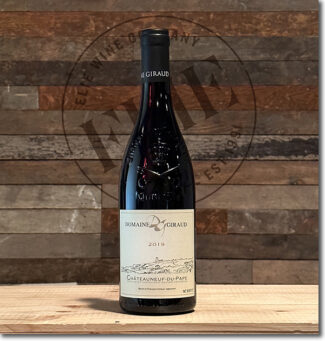 2. Domaine Giraud ‘Tradition’, 2019 Châteauneuf-du-Pape ($58)
2. Domaine Giraud ‘Tradition’, 2019 Châteauneuf-du-Pape ($58)
Red from red: Grenache, Syrah, Mourvèdre grown among the pebbles in the red clay soils of southern Châteauneuf-du-Pape. The vines, from the Bois de la Ville, la Cerise, les Galimardes, le Tresquoys and Valori lieu-dits, are between 60 and 85 years old, each certified organic. The blend is nearly 60% Grenache followed by Syrah and small amount of Mourvèdre fermented separately; the Syrah in French oak barrels with the Mourvèdre and Grenache in stainless steel and concrete. The wine shows cherry liqueur and lavender flavors with Provençal herbs, licorice, and loamy earth. The tannins are polished and the finish long and complex.
Clos Saint Jean (AOP Châteauneuf-du-Pape)
Founded in 1900 by Edmund Tacusel, Clos Saint Jean is currently owned by Pascal and Vincent Maurel, Edmund’s great-great grandsons. Under the watchful eye of the late enologist Philippe Gambie, Clos Saint Jean has become the preeminent estate espousing the modern style of winemaking in Châteauneuf.
The various vineyards of Clos Saint Jean are located primarily in the region of Le Crau. This plateau is perhaps the most iconic of the many terroirs of Châteauneuf-du-Pape, iron-rich red clays topped with pebbles. While about 60% of their vineyards are located here, specifically in the lieu-dits of Côteau de Saint Jean and Cabane de Saint-Jean, another 40% are located in alluvial clay and sandy soils adjacent to the plateau. They also own a small parcel of Mourvèdre in the lieu-dit of Bois-Dauphin near Château Rayas planted on sandy, limestone-rich soils.
The farming at Clos Saint Jean is fully sustainable due to the warm and dry climate which obviates the need for chemical inputs. Vincent and Pascal employ organic methods for pest control, mainly pheromones to prevent pests from taking up Le Crau with Châteauneuf-du-Pape on the horizon.
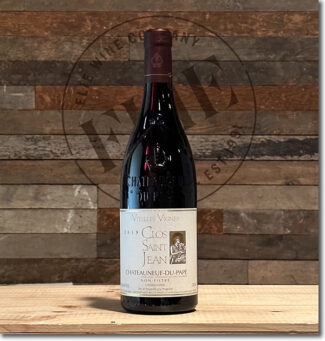 3. Clos Saint Jean ‘Vieilles Vignes’, 2019 Châteauneuf-du-Pape ($58)
3. Clos Saint Jean ‘Vieilles Vignes’, 2019 Châteauneuf-du-Pape ($58)
A blend of Grenache, Syrah, Mourvèdre, Cinsault, Vaccarèse and Muscardin from the Le Crau lieu-dits of Côteau de Saint Jean and Cabane de Saint- Jean and a small parcel of Mourvèdre in the lieu-dit of Bois-Dauphin near Château Rayas planted on sandy, limestone-rich soils. The wine features waves of warmed plum sauce and blackberry purée flavors laced with licorice root and tobacco.
Burgundy: Pinot Noir With Authority
Burgundy’s wine-producing area stretches almost 300 km, from Joigny in Yonne to Mâcon in Saône et Loire. It consists of 5 large vineyard areas; from north to south, Chablis and Grand Auxerrois (in Yonne), Côte de Nuits (in Côte d’Or), Côte de Beaune (in Côte d’Or) Côte Chalonnaise (in Saône et Loire) and Mâconnais (in Saône et Loire )
Burgundy is both the easiest and the most difficult wine region in France to understand. It’s easy in terms of grape varieties: most of the reds are from Pinot Noir, the whites from Chardonnay. Although there are a few small plantings of Aligoté and Gamay scattered throughout Burgundy, the region remains the world’s gold standard for Pinot Noir and Chardonnay.
The arise from grasping the extreme variety of difficulties of terroirs in Burgundy, where vineyard ownership is highly fragmented, resulting in a countless number of producers. In Burgundy, it’s common for a grower to own just a few rows of vines in a vineyard.
[$156] Côte de Beaune Set
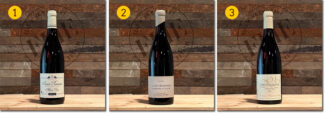
Dijon is Burgundy’s official capital, but unless you’re interested in cellar-aging Gray Poupon, it’s better to think of the spiritual center for all things wine: Beaune. It’s the town where the bacchanalian brotherhood Confrérie des Chevaliers du Tastevin meet, and home to the magnificent Hospices de Beaune, where the world’s most famous wine auction is held in November of each year.
The Côte de Beaune is a narrow strip of land less than 3 miles wide and about 16 miles long that runs in a north-easterly direction from the river Dheune. The climate is continental, with slightly higher temperatures and more rainfall than in its sister appellation, the Côte de Nuits. Vineyards are planted to 58% Chardonnay, with Pinot Noir representing 42% (the rest are Aligoté, Pinot Blanc and Pinot Gris). Red wines from this appellation tend to be bright and fruit-forward in youth; meaty and savory with age.
Domain Alain Gras (AOP Saint-Romain)
Saint-Romain is a village of 200 inhabitants nestling within a valley behind Auxey-Duresses and surrounded by steep cliffs. Neither the population nor the wine trade ever really recovered from the phylloxera blight of the 19th century, and today, only about 7% of the land is under vine. Like Chorey-lès-Beaune, Saint-Romain has no Grand or Premier Cru sites.
The village is divided into two parts, Saint-Romain-le-Haut and Saint-Romain-le-Bas, one on top of the cliffs and one below, with the bulk of the vineyards in the lower section. It is, however, a geologist’s Valhalla. Saint-Romain sits on the lias (the earliest period of the Jurassic) and the blend of limestones and marls includes patches of clay. The vines face south/southeast and north/northeast at altitudes varying from 900 to nearly 1300 feet.
Established in 1979, Alain Gras refers to his domain as ‘young’, and considering that Saint-Romain has been occupied for 6000 years, there may be truth to that. His vines spread over 30 acres in Saint-Romain, Meursault, and Auxey-Duresses.
Gras has found himself as a true ambassador of the Saint-Romain appellation. From a lineage of Burgundy vignerons that dates back five generations, he settled in Saint-Romain with his wife Nathalie and from the outset, their firm mission was to promote the appellation’s value. Joined by his son Arthur, Gras has advanced that value by his passion for rational viticulture and traditional vinification.
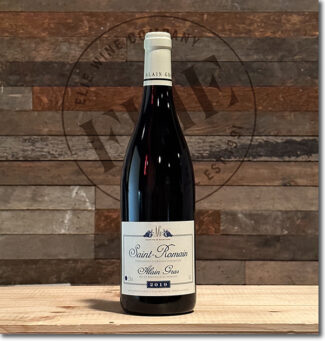 1. Domaine Alain Gras, 2019 Saint-Romain ($54)
1. Domaine Alain Gras, 2019 Saint-Romain ($54)
Pure Pinot Noir from vines averaging 35 years old; the bunches are 100% de-stemmed, fermented on the skins for 12 to 15 days with daily pump-overs, then aged in 15% new oak for 12 months. The wine shows black-cherry on the nose with notes of licorice and cinnamon in the background. Unpretentious wine with a bright floral finish.
Domaine Raymond Dupont-Fahn (AOP Auxey-Duresses)
Orientation saves Auxey-Duresses from the ranks of the ordinary. Surrounded by the hills of Mont Melian, Montagne du Bourdon and Montagne du Tillet, Auxey-Duresses is stretched out along the Beaune-Autun road between Monthélie and Saint-Romain, and the hillsides face south and southeast. This geological quirk, along with the limestone content of the soil, has led to nine designated Premier Cru climats, all located on the south-facing Montagne de Bourdon hillside just behind the commune, and some excellent Village-level wines. In fact, a significant proportion of Auxey-Duresses’ production is sold under the Côte de Beaune-Villages appellation, but with rising temperatures and an increasing interest in Burgundy’s backcountry wines, the value of the commune appellation is increasing year after year.
Raymond Dupont-Fahn is a fifth generation wine maker and began working in the family business as a child. After earning a Bac d’Oenologie diploma, he took over 12 acres of vines from his father, including plots in Meursault, Puligny-Montrachet and Auxey-Duresses. The domain is located in the village of Tailly in Meursault. As a winemaker, Raymond has cut down on the use of new oak from the 40% used by his father to just 10%, with barrels that are no older than three years. He uses no pesticides in the vineyards, aiming to be as sustainable as he can, and harvests slightly earlier than his neighbors to produce wines with better acidity and lower alcohol.
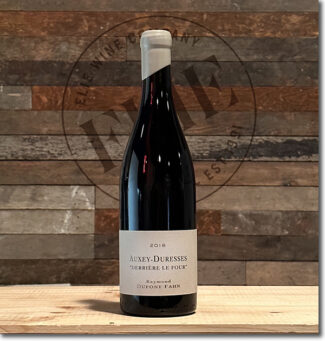 2. Domaine Raymond Dupont-Fahn, 2018 Auxey-Duresses ‘Derrière le Four’ ($50)
2. Domaine Raymond Dupont-Fahn, 2018 Auxey-Duresses ‘Derrière le Four’ ($50)
Meaning ‘behind the oven’, the wine is silky on the palate, with a fine texture entwining around a core of cherries, peonies and a hint of licorice. 100% Pinot Noir, of course, filled with structure and finesse.
Domaine Vincent Ledy (AOP Savigny-lès-Beaune)
Chances are, you love wines from the Rhine and are passionate about wines from the Rhone, but at first glance, ‘wines of the Rhoin’ may look like a typo. In fact, this small river flows from the cliffs of Bouilland through the commune of Savigny-lès-Beaune , and alluvia from the overflow adds fertility to the lower slopes of the hills of Beaune. With nearly nine hundred acres of vineyard, the appellation is one of Burgundy’s largest.
Savigny’s terroir features a gentle gradient that becomes steeper as the altitudes approach 1300 feet, where the geology is similar to that of the great Grand Cru hill of Corton. Favored exposures face the south, where the soils are gravelly and scattered with oolitic ironstone. Near the river valley, the red-brown limestone becomes more clayey and pebbly, while the east-facing slopes consist of sand and limestone.
As rich in history as it is in Premier Cru vineyards (there are 22), Savigny-lès-Beaune was once a social hub where the nobility and clergy rubbed shoulders, and the near mythical regard for the quality of its wine is reflected in a stone carving on a Savigny chateau: “The wines of Savigny are nourishing, theological and keep death at bay.”
Eight years of wine school may make you think of a professional student, but Vincent Ledy took all that accumulated scholastics and applied it to one of the smallest domains in Nuits-Saint-Georges. Scarcely five acres in total, he produces six labels for a total of 8,500 bottles.
“My first vintage was 2007”, he says. “All I had was a red Hautes-Côtes de Nuits. In 2008, I increased the size of the domain a little bit when I found a very small plot for Bourgogne rouge, less than a quarter acre just opposite of Clos de Vougeot on the other side of the Beaune-Dijon road. The soil is deep clay that is reflected in the character of the wine; blackcurrant is the dominating flavor, the same every vintage. Compared with the Bourgogne Hautes-Côtes de Nuits it is very different. The Hautes-Côtes is more about cherry flavors. The maximum yield for the regional appellations is 58 hl/ha, but the yield for my Bourgogne rouge is 50 hl/ha.”
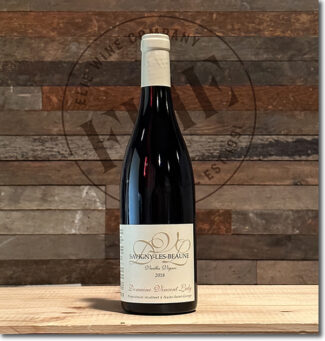 3. Domaine Vincent Ledy ‘Vieilles Vignes’, 2018 Savigny-lès-Beaune ($52)
3. Domaine Vincent Ledy ‘Vieilles Vignes’, 2018 Savigny-lès-Beaune ($52)
From the Villages-level lieu-dits Connardises and Aux Liards, the wine shows vivid ruby colors with garnet red tints. Violet, sweet pepper and hints of toast on the nose, followed by a silken palate and red fruit notes including cloudberry and ripe cherry.
[$222] Coast of Nights Set
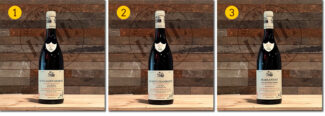
‘Côte de Nuits’ is a name that excites the senses; it is mysterious (the name means ‘hills of the night), it is sensuous (95% of its output is built around silk-smooth, hedonistic Pinot Noir) and it is evocative, with wine aromas frequently liked to roses and the spice- box. Hold a bottle of Côte de Nuits in your hands and you hold a key to a kingdom which produces the finest Pinot Noirs in the world. But the grape itself is a mystery within a mystery, and making sense of the individual styles and terroirs of the revered red wine vineyards of Côte de Nuits’ cannot be accomplished with a single bottle. Every village has its story and every vineyard its history; the wines vary by texture, color and dominant flavor notes.
The terroir of Côte de Nuits is built upon a pixel-like plan of vineyards that seems more like a maze than a map. Exposure is vital, and it’s said (tongue-in-cheek) that all the Grand Crus face Germany. The truth is, most of Burgundy is marginal grape country, and the farther north you go, the tougher it gets. But given the opposite conditions—compost-rich soil, plenty of sunshine and a long growing season with copious rainfall—you end up with happy vines that do not produce particularly complex wines. The stony soils of the Côte de Nuits’ Grand Crus excel chiefly because they are poor; the limestone bedrock offers abundant levels of elemental calcium, which helps open up the capillaries in the soil, increasing porosity and assisting root colonization. Stone fragments add to the drainage capability of the soil and reciprocally,
Domaine Jean-Michel Guillon & Son
‘Local boy makes good’ is a common enough tale in Burgundy, where land—which can command a price tag twice that of Bordeaux—is generally held by families. Most success stories involve inheriting it or marrying it. Rare is the breakthrough of an outsider who can, for example, step off a train in Gevrey-Chambertin without connections or formal wine training and forge a Burgundian empire within an enclave already pretty imperialistic.
Enter Jean-Michel Guillon. Born into a military tradition, Jean-Michel Guillon chose to settle in France after his past service in the Polynesian Islands and in 1980, without much formal training, planted grapes on five acres of land. What began as a nascent fascination grew into an overarching passion, and the estate today covers nearly forty acres spread over more than 20 appellations. It is work that, like the best Gevrey-Chambertin wines, took years to peak, both stylistically and critically: 2020 turned out to be Jean-Michel Guillon’s best vintage ever.
He explains: “It is all the result of my love for this land, and any acclaim I have received is based on innovative production processes and more importantly, taking into account the ecological needs of the vine. The climate crisis and the scarcity of natural materials is taken very seriously at the winery. Global warming is at the heart of the destruction of habitat destruction and the appearance of certain diseases. In order to facilitate cultivation and harvesting, we have worked diligently to reduce our carbon footprint by using phytosanitary products that respect the environment.”
Most Burgundy fans recognize Nuits-Saint-Georges as the focal point of the Côte de Nuits, and it is such quintessential Pinot Noir country that this varietal makes up more than 97% of the plantings. The soils in the northern sector derive from pebbly alluvia washed down from up-slope, and in the low-lying parts from the silty deposits of the River Meuzin. In the southern sector the alluvia at the base of the slope originate in the combe of Vallerots where there are deep marly-limestone soils, while at the top of the slope, the rock is almost at the surface. Exposures are mostly to the east or southeast, and while the appellation does not contain any Grand Cru vineyards, its 41 Premier Cru sites are rated among the finest in the region.
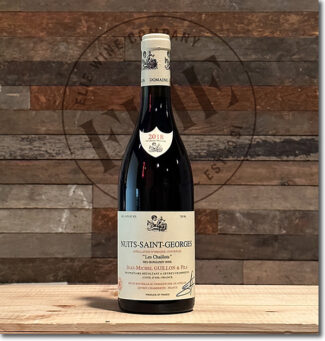 1. Domaine Jean-Michel Guillon & Fils, 2018 Nuits-Saint-Georges ‘Les Chaillots’ ($83)
1. Domaine Jean-Michel Guillon & Fils, 2018 Nuits-Saint-Georges ‘Les Chaillots’ ($83)
At the age of 26, having studied viticulture and oenology and put in six years with a communications firm in Paris, Thibault Liger-Belair gave in to his true passion and began to make wine. The following year (2002) represented his first harvest of Nuits-Saint-Georges, Nuits-Saint-Georges Charmottes, as well as Vosne-Romanée Aux Réas. Les Grands Chaillots is an assemblage of different terroirs; a third originates in his own Nuits-Saint Georges vineyards and the rest is purchased from various parcels Marsannay and Ladoix Serrigny. Says Liger-Belair: “This wine is a little Chambolle-like in style. The palate is sweet and candied on the entry with blood orange fusing with red cherry/kirsch notes with good delineation on the finish.”
In the far northeast of Burgundy, about ten south of Dijon with the valley of Saône valley to the east lies the Rodeo Drive of red wine, Gevrey-Chambertin . The town itself is touristy, picturesquely festooned with vineyards from end to end, but certainly one of the must-visit areas on any French wine tour. Should the tour include a tasting (and if it doesn’t, skip it), you’ll find that the wine, at all levels of quality, share certain characteristics, many of them in seeming contradiction: In general, Gevrey wines are big without being heavy, rich without being cloying and full-bodied while retaining a velvety, delicate texture.
This inherent tension is what makes Gevrey-Chambertin a superlative, even in the star-studded Côte de Nuits. But it must be remembered that this quality represents many centuries of trial and error: The best vineyards are based around the foothills of the famous hill of Lavaux, on the east-facing slope where they are hit by the morning sun, which disperses any fog and warms the vineyard into the late afternoon. Soils, of course, impart their geological magic–the vines in the Premier and Grand Cru sites are grown on shallow brown limestone with sections of clay which holds onto the heat of the day, warming the vines overnight and further increasing their ripeness and power. Organoleptically, the Pinot Noirs of Gevrey suggests blackcurrants and jammy strawberry compote when young, with distinct notes of licorice heightened by maturation in new oak casks. As these wines age, they acquire earthy notes aromas that hint at animal pelts, musk, spicy vanilla and Havana cigars. The top-flight Crus are unparalleled, of course, and no more apt descriptor for them exists than ‘blood and iron.’
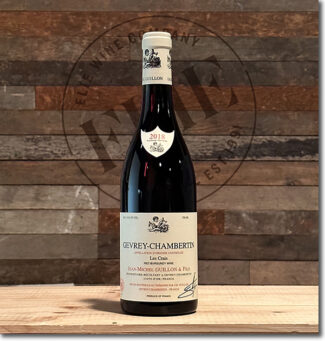 2. Domaine Jean-Michel Guillon & Fils, 2018 Gevrey-Chambertin ‘Les Crais’ ($78)
2. Domaine Jean-Michel Guillon & Fils, 2018 Gevrey-Chambertin ‘Les Crais’ ($78)
The Pinot Noir parcel ‘Les Crais’ sits east of the main road on the Brochon side of Gevrey-Chambertin; it was planted in two parts, one in 1979/1980 and the other in 1990/1991. Soils are gravel made of decomposed limestone. The wine is racy and intense with juicy raspberry aromas, ripe cherry and anise sparks, offering remarkable length.
Marsannay is the northernmost village in Burgundy’s heart and is a stellar introduction to the galaxy of possibilities offered by the Côte d’Or. That is because, as a fairly new invention within the wine hierarchy (Marsannay only achieved village status in 1987, prior to which its grapes were used for regional wines), price has not yet caught up to quality, even among other Village-level wine .
Perhaps more than in any other wine region, Burgundy’s fans are label-obsessed and purchase accordingly—and appropriately. Since Marsannay contains none of the storied Grand or Premier Crus in the carefully delineated Burgundy classification system, these wines represent unparalleled value, especially since many individual estates have forged new commitments to improve what history and nature has provided.
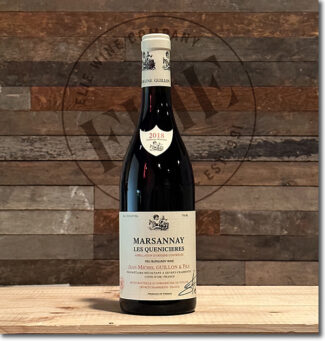 3. Domaine Jean-Michel Guillon & Fils, 2018 Marsannay ‘Les Quenicières’ ($61)
3. Domaine Jean-Michel Guillon & Fils, 2018 Marsannay ‘Les Quenicières’ ($61)
Lavishly oaked with creamy and toasty aromas behind the floral—peony, iris and clove. The mouth is round and gourmet while revealing blackcurrant and spicy aromas with elegant tannins on the finish and persistent minerality behind earthy notes of fern, moss and truffle.
[$145] Coast of Nights Backcountry Set
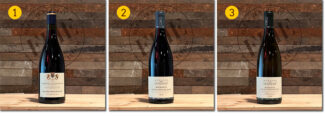
Not recognized officially until 1961, the Hautes Côtes region covers 16 communes in the department of Côte-d’Or, plus the more elevated areas of four communes in the Côte de Nuits. The dividing line between the Hautes Côtes de Nuits and the Hautes Côtes de Beaune runs through the village of Magny-Iès-Villers.
Overlooking the slopes of Gevrey-Chambertin and extending as far as the wood of Corton, the Hautes Côtes de Nuits is known for wild and rugged beauty and the red wines for being attractive balanced between flesh and tannins and the few whites being vivacious and fresh. The vineyards cover all these slopes which enjoy favorable exposures and proudly preserve their proof of nobility going back to Vergy and the abbey of Saint-Vivant.
The appellation name can only be granted after the wines have been subjected to certification via tasting and analysis.
Domaine Thibault Liger-Belair (AOP Hautes-Côtes de Nuits)
The estate (originally called Comte Liger-Belair) was created in 1720 in Nuits-Saint-Georges, and soon became one of the most important wine growing and trading houses in Burgundy. After many years and successive generations had met with varying degrees of success, Thibault Liger-Belair took over in 2001, and found the 20-acre estate in need of some attention. His immediate switch to organic farming was a matter of necessity as much as responsible stewardship: “The vineyards were in a bad condition, with compacted soils. I couldn’t do anything else other than organics,” he says, and in 2004, he discovered biodynamics: “I saw a change in my vineyard, which went from gray soils to brown/red and then sometimes to black.”
Still, his overarching philosophy is that each vineyard needs something different: “I don’t like 100% of anything: new barrels, whole clusters, etc. My job is to decide which grapes we have and then decide a viticulture and winemaking approach.”
In 2018, he made wine from 23 different appellations and purchased grapes from a ten more, where he had worked the vines himself. “We don’t buy grapes where we don’t do the work,” he maintains.
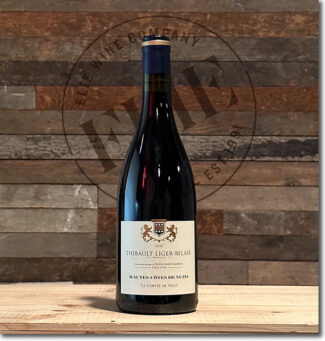 1. Domaine Thibault Liger-Belair ‘Corvée de Villy’, 2018 Hautes-Côtes de Nuits ($49)
1. Domaine Thibault Liger-Belair ‘Corvée de Villy’, 2018 Hautes-Côtes de Nuits ($49)
‘Corvée de Villy’ is a bit more than an acre and a half of stony earth in the upper reaches of Nuits-Saint-Georges on the Lime plateau. It was planted to Pinot Noir in 1988 and according to Liger-Belair, is comprised of a specific blend of two soils that influence the wine in two steps:
“The first 30 centimeters of the soil are composed of red-orange lava clays rich in ferrous elements and then it is the primary limestone that formed the basis for the creation of the Côte. The nose is floral with the aromas of red fruits; the palate is richer and more ‘gourmet’ on first impressions and finishes with freshness and minerality brought by the limestones.” 3,300 bottles made.
Domain Lécheneaut (AOP Hautes-Côtes de Nuits)
Having been founded in the 1950s by Fernand Lécheneaut, the domain launched modestly with five acres of vineyard in Nuits-Saint-Georges, Chambolle-Musigny and Morey-Saint-Denis. During these early years, Lécheneaut sold bulk wine to traders, but in 1985, his sons Philippe and Vincent took over and brought with them an expanded vision. They grew their vineyard holdings while they began to bottle at the estate. The new Lécheneaut plots, including several Premier Cru vineyards in Chambolle-Musigny and Gevrey-Chambertin, speckle the map of the Côte de Nuits from north to south, but judiciously—many of the holdings are under an acre. With vines in 23 appellations, the total land under their management is around thirty acres.
As the Lécheneaut brothers approach retirement, Vincent’s son Jules has joined the team with a view toward combining lessons learned in his experiences working vines in Oregon with the exceptional terroir his family nurtures.
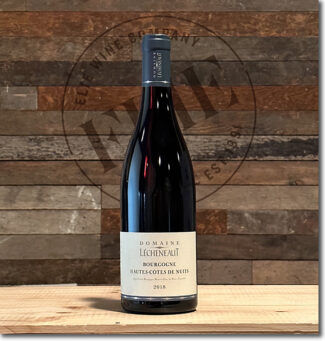 2. Domaine Lécheneaut, 2018 Bourgogne Hautes-Côtes de Nuits ($49)
2. Domaine Lécheneaut, 2018 Bourgogne Hautes-Côtes de Nuits ($49)
From a two acre plot on the same Jurassic chalk plateau, from vines with an average age of 63 years. The wine is beautifully balanced, with aromas of raspberry, black cherry and licorice. Direct and firm flavors with granular, but well-integrated tannins. 7500 bottles made.
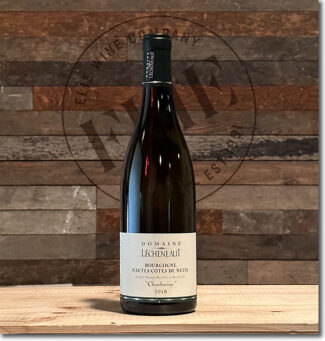 3. Domaine Lécheneaut, 2018 Bourgogne Hautes-Côtes de Nuits White ($47)
3. Domaine Lécheneaut, 2018 Bourgogne Hautes-Côtes de Nuits White ($47)
Situated on a hillside facing south at about 1150 feet, the vines cover the sloping valley cutting through the Jurassic chalky plateau, west of the Côte. The substrate is identical to that of the vine covered hillside, but the surface formations are very thin, at times non-existent. The chalky-clay soils are a result of the alteration of the limestone and marls substrate and are ideal for Chardonnay. The wine shows hawthorn and honeysuckle on the nose, which mingles on the palate with buttery apple, lemon, and hazelnut. Vines average 25 years old; 2100 bottles made.
Bordeaux: The Art of The (Cabernet+Merlot+Cabernet Franc) Blend
Bordeaux is a tale of two banks, split in two by the Gironde Estuary; Bordeaux wines are often described by the side of the river where the chateaux are found. As the little brother is often overshadowed by the elder, so the First Growths of Bordeaux’s Left Bank have often basked in the brightest spotlights while those found along the Right Bank have hovered in the wings. Robert Parker Jr. may be credited (at least in part) for bringing some of these understudies center stage with critical high-fives and scores in the 90s. This is because Right Bank wines tend to be more in tune with his preferred style—plush, juicy and jammy with melt-away tannins, due in part to its soils being often better suited to soft, early-ripening Merlot rather than the austere, big-shouldered and acidic Cabernet Sauvignon that predominates in the Left Bank.
[$225] Pauillac Set
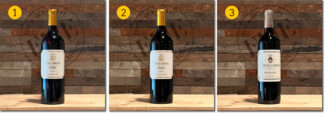
For an appellation slightly under 3000 acres—only nine square miles—Pauillac, on the left bank of the Gironde estuary—boasts a surprisingly varied terroir. Top estates, including three of the five First Growth castles in the 1855 Classification, are located near the river, and each has built a reputation on emphasizing their differences rather than their similarities. A practiced oenophile can tell them apart by a whiff from the glass. And beyond the wine, that whiff also provides a vision into Bordeaux’s family history.
The single factor that all classified Pauillacs have in common is that their cuvées are built around a primary grape variety, Cabernet Sauvignon. Most Pauillac is comprised of at least 70% Cabernet Sauvignon, which struts its stuff amid the maritime climate and gravelly soil of southwest France better than anywhere else on earth. The irony, of course, is that what it brings to the table is enhanced, rather than masked, by the addition of complimentary grapes. As such, Cabernet Franc, Merlot, Carmenère, Petit Verdot and Malbec are also permitted under the Pauillac appellation laws. It is the art of the blend that creates the uniqueness in Pauillac wines; the hallmark of the individuality that is the Holy Grail of the appellation’s winemakers.
Château Pichon-Comtesse (AOP Pauillac)
With a focus on ‘impeccable land stewardship’, Château Pichon-Longueville-Comtesse-de-Lalande’s 1982 vintage garnered a perfect 100 points from wine critic Robert Parker. That is one of the reasons the estate is often referred to as a ‘Super Second’, meaning that it consistently produces wine to rival the First Growths classified in 1855 despite its official status as a Second Growths, or Second Growth.
In 2006, the majority interest in Château Pichon-Longueville was sold to the Rouzaud family, which also owns the Champagne house Louis Roederer.
All five Bordeaux grapes are grown on the estate’s two hundred acres, dominated by Cabernet Sauvignon, Merlot and Petit Verdot. Wines from Comtesse de Lalande are considered among the most voluptuous wines in the Médoc due to the high proportion of Merlot used in the final blend; the increasing proportion of Cabernet used in modern cuvées to add structure does not diminish the amount of Merlot used; it means less of the other varieties. The current varietal reflects the vineyard plantings, roughly 65% Cabernet Sauvignon, 25% Merlot, 7% Cabernet Franc and 3% Petit Verdot. The heart of these plantings is a 150-acre parcel of vines situated southwest of Pichon Baron, close to the manor. The best parcels overlook the river and are filled with vines with an average age of 40 years, although the oldest vines are nearly 90,
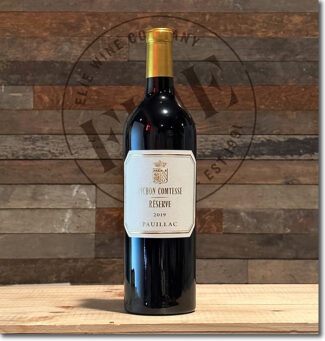 1. Château Pichon Comtesse ‘Pichon Comtesse Réserve’, 2019 Pauillac ($75)
1. Château Pichon Comtesse ‘Pichon Comtesse Réserve’, 2019 Pauillac ($75)
51% Cabernet Sauvignon, 46% Merlot and 3% Cabernet Franc, the wine offers intense blackberry and briary scents mixed with mint. Crafted with superb precision, it is a remarkable value for a Second Wine and promises to age well in the bottle.
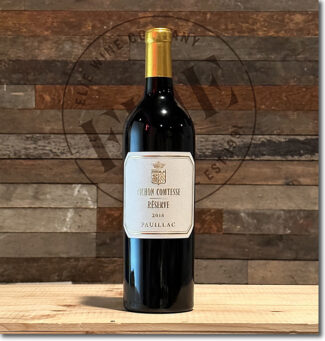 2. Château Pichon Comtesse ‘Pichon Comtesse Réserve’, 2018 Pauillac ($69)
2. Château Pichon Comtesse ‘Pichon Comtesse Réserve’, 2018 Pauillac ($69)
A textbook Pauillac second wine that outstrips many of Pauillac’s first wines. An early-drinking incarnation of Pichon Comtesse’s Grand Vin, the blend is 53% Cabernet Sauvignon and 42% Merlot with the balance Petit Verdot and Cabernet Franc. The name changed with the 2017 vintage, becoming the-wine-formerly-known-as-‘Reserve de la Comtesse’; the new name is cleaner and the label somewhat sleeker. The wine remains, as always, plush and round, with silken black fruit on the fore-palate and vibrant with ripe raspberries and baked plums above licorice, cedar, ground cloves and wood smoke.
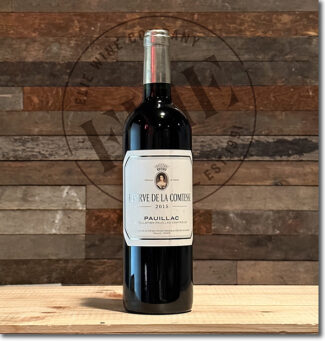 3. Château Pichon Comtesse ‘Pichon Comtesse Réserve’, 2015 Pauillac ($81)
3. Château Pichon Comtesse ‘Pichon Comtesse Réserve’, 2015 Pauillac ($81)
A blend of 53% Cabernet Sauvignon, 40% Merlot and the balance, Cabernet Franc and Petit Verdot. 2015 was a brilliant vintage and the wines continue to develop; this one surpasses most châteaux’ Grand Vins with deeply expressive notes of black cherry, graphite, smoke, licorice and incense.
[$299] Saint-Estephe Set
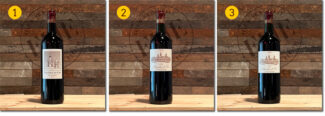
Located at the northern end of the Haut-Médoc in an undulating sea of quartz, pebbles, clay and limestone, the wines of Saint-Estèphe are known for both finesse and longevity. Accounting for nearly 8% of total Médoc production, the terroir of Saint-Estèphe is considered among the most favorable in Bordeaux—the limestone is ideal for Cabernet Sauvignon, while the heavier, moisture-retaining clay favors Merlot; the two varietal that make up the lion’s share of Bordeaux blends.
Château Cos d’Estournel (AOP Saint-Estèphe)
Cos d’Estournel is found amid undulating terrain at very heart of Médoc, and the name itself was chosen by the original owner, Louis Gaspard d’Estournel, to commemorate the rolling landscape on which the estate stands; ‘cos’ is an old dialectical word for hill. Known for its ornate, pagoda-topped castle, Cos d’Estournel was purchased in 2000 by entrepreneur Michel Reybier, a man determined to keep the extraordinary personality of the estate intact. “It will be Cos and only Cos,” he insisted at the time and maintains to this day: “At first glance, I was attracted by the history of the place. And then when I visited the estate, I instantly felt how unique, how exceptional it is.”
With roots sunk deeply in tradition, d’Estournel is nevertheless quite happy to employ state-of-the-art technique, and despite the labor-intensity of the entire process, much of it is hands off: Upon arrival, the temperature of the grapes is lowered to around 40 degrees Fahrenheit to slow oxidation, and then is cold macerated with pump-overs done entirely by gravity recycling. Gravity cellars allow for complete nonintervention in making the wine, and the use of this method allows for the purest possible expression of the fruit grown in the gravelly, rock, and stone soils of Cos d’Estournel.
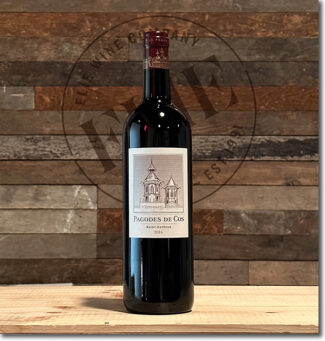 1. Château Cos d’Estournel ‘Les Pagodes’, 2016 Saint-Estèphe ($74)
1. Château Cos d’Estournel ‘Les Pagodes’, 2016 Saint-Estèphe ($74)
2016 was a superb vintage in northern Médoc, and especially in Saint-Estèphe. 76% Cabernet Sauvignon, 23% Merlot and 1% Cabernet Franc, the wine delivers blackberry, citrus, spice, earth and cassis.
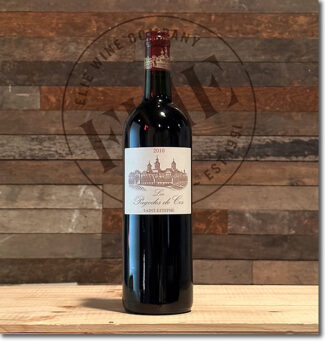 2. Château Cos d’Estournel ‘Les Pagodes’, 2010 Saint-Estèphe ($110)
2. Château Cos d’Estournel ‘Les Pagodes’, 2010 Saint-Estèphe ($110)
2010 produced charming and classically styled wines throughout Saint-Estèphe, with the majority of estates producing wine with ample concentration of fruit and soft, sweet tannins.
This blend of 43% Merlot, 55% Cabernet Sauvignon and 2% Petit Verdot is matured in 50% new oak. It shows cherry paste, chocolate, menthol, licorice and dark spices running through cedar and graphite with of tobacco and allspice putting in a late appearance.
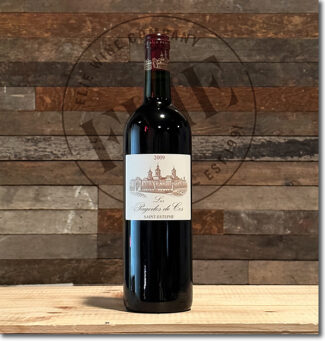 3. Château Cos d’Estournel ‘Les Pagodes’, 2009 Saint-Estèphe ($116)
3. Château Cos d’Estournel ‘Les Pagodes’, 2009 Saint-Estèphe ($116)
2009 was a fine vintage for St. Estèphe, with Cabernet Sauvignon performing especially well, with dense, but perfectly ripe tannins and phenolic ripeness across the board. This wine is drinking beautifully, with a deep, opaque purple hue and a vibrant bouquet of blackberries, cherries, plum and d’Estournel’s characteristic Asian spices. The finish shows a hint of cedar with a depth of fruit rising from well-aged aromatics.
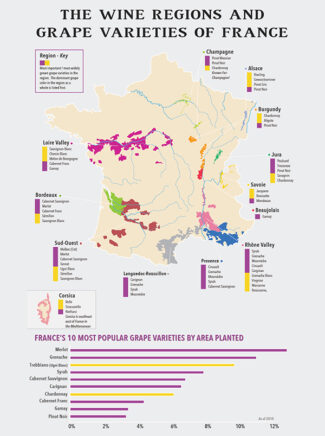
- - -
Posted on 2022.12.24 in France
Featured Wines
- Notebook: A’Boudt Town
- Saturday Sips Wines
- Saturday Sips Review Club
- The Champagne Society
- Wine-Aid Packages
Wine Regions
Grape Varieties
Albarino, Albarín Blanco, Albarín Tinto, Albillo, Aleatico, Aligote, Arbanne, Aubun, Barbarossa, barbera, Biancu Gentile, bourboulenc, Cabernet Franc, Caino, Caladoc, Calvi, Carcajolu-Neru, Carignan, Chablis, Chardonnay, Chasselas, Cinsault, Clairette, Corvina, Counoise, Dolcetto, Erbamat, Ferrol, Frappato, Friulano, Fromenteau, Gamay, Garnacha, Garnacha Tintorera, Gewurztraminer, Graciano, Grenache, Grenache Blanc, Groppello, Juan Garcia, Lambrusco, Loureira, Macabeo, Macabou, Malbec, Malvasia, Malvasia Nera, Marcelan, Marsanne, Marselan, Marzemino, Mondeuse, Montanaccia, Montònega, Morescola, Morescono, Moscatell, Muscat, Natural, Niellucciu, Parellada, Patrimonio, Pedro Ximénez, Petit Meslier, Petit Verdot, Pineau d'Aunis, Pinot Blanc, Pinot Gris, Pinot Meunier, Pinot Noir, Pouilly Fuisse, Pouilly Loche, Poulsard, Prieto Picudo, Riesling, Rondinella, Rose, Rousanne, Roussanne, Sagrantino, Sauvignon Blanc, Savignin, Sciacarellu, Semillon, Souson, Sparkling, Sumoll, Sylvaner, Syrah, Tannat, Tempranillo, Trebbiano, Trebbiano Valtenesi, Treixadura, Trousseau, Ugni Blanc, vaccarèse, Verdicchio, Vermentino, Xarel-loWines & Events by Date
- July 2024
- June 2024
- May 2024
- April 2024
- March 2024
- February 2024
- January 2024
- December 2023
- November 2023
- October 2023
- September 2023
- August 2023
- July 2023
- June 2023
- May 2023
- April 2023
- March 2023
- February 2023
- January 2023
- December 2022
- November 2022
- October 2022
- September 2022
- August 2022
- July 2022
- June 2022
- May 2022
- April 2022
- March 2022
- February 2022
- January 2022
- December 2021
- November 2021
- October 2021
- September 2021
- August 2021
- July 2021
- June 2021
- May 2021
- April 2021
- March 2021
- February 2021
- January 2021
- December 2020
- November 2020
- October 2020
- September 2020
- August 2020
- July 2020
- June 2020
- May 2020
- April 2020
- March 2020
- February 2020
- January 2020
- December 2019
- November 2019
- October 2019
- September 2019
- August 2019
- July 2019
- June 2019
- May 2019
- April 2019
- March 2019
- February 2019
- January 2019
- December 2018
- November 2018
- October 2018
- September 2018
- August 2018
- July 2018
- June 2018
- May 2018
- April 2018
- March 2018
- February 2018
- January 2018
- December 2017
- November 2017
- October 2017
- September 2017
- August 2017
- July 2017
- June 2017
- May 2017
- April 2017
- March 2017
- February 2017
- January 2017
- December 2016
- November 2016
- October 2016
- September 2016
- August 2016
- July 2016
- June 2016
- May 2016
- April 2016
- March 2016
- February 2016
- January 2016
- December 2015
- November 2015
- October 2015
- September 2015
- August 2015
- July 2015
- June 2015
- May 2015
- April 2015
- March 2015
- February 2015
- January 2015
- December 2014
- November 2014
- October 2014
- September 2014
- August 2014
- July 2014
- June 2014
- April 2014
- March 2014
- February 2014
- January 2014
- December 2013
- November 2013
- October 2013
- September 2013
- August 2013
- July 2013
- June 2013
- May 2013
- April 2013
- March 2013
- February 2013
- January 2013
- December 2012
- November 2012
- October 2012
Search



